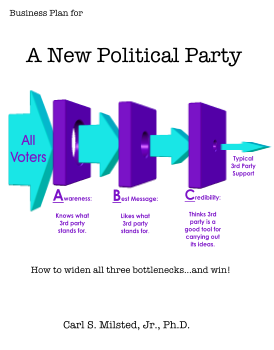Geographic Focus
Elsewhere I have made the suggestion that a third party can get away more with geographic focus than demographic focus. Now itís time to flush out the idea.
We run into an immediate problem: geographic focus contradicts some of the low-hanging fruit outreach techniques. A web site is national, nay international, in scope. It may happen that many are recruited from areas that are difficult to do third party politics in.
One fair solution is to emphasize locally deployed outreach. If the national party provides outreach materials to be used at outreach tables, then those materials will get deployed by the active local parties. If the national party provides footage for television and radio spots, this footage will be used by affiliates able to afford to air this footage.
So, even though I will speculate here on where optimal geographic focus should be, there need not be much in the way of top-down decision-making. The primary decision to be made is to avoid an infill-mentality. The party should not expend resources trying to build up where it is weak for completeness sake. The central office should do the easy dispersed recruitment and provide tools for growth where there is interest.
Here are some possible way in which geographic focus could be applied:
-
Go after the small cities, especially those which have self-contained media markets. Politicians running in large metropolitan areas have a hard time buying media that is contained within a political district. This results in a need for direct mail and phone solicitation vs. radio and TV.
-
Go after small states, especially those with many state house districts. With small districts, a single active party member can get elected using personal popularity.
-
Go after states where ballot access is affordable. Save the difficult ballot access states until after the party gets big enough.
-
When subsidizing ballot access for a difficult state, also subsidize a massive membership drive so that the party can keep, or at least renew, ballot access on its own. If you cannot afford the subsidy for membership, donít bother with ballot access.
-
Very red or very blue areas allow the third party to locally be the second party.
-
Go after areas where you have sympathetic media.
-
Go after culture clash areas. Such areas are open to new ideas. (This is why I moved to Asheville, NC.)
A fair excuse for implementing Option 1 at the national level would be to do experiments with television and radio as membership tools. Such experiments are much cheaper in small media markets. Radio and TV spots are more effective when they saturate a small market vs. touch a big market. I would really love to see what would happen if a third party were to truly saturate local radio in a rural area. This could be combined with newspaper ads and direct mail.
A lottery could be used to determine which markets to try such experiments in order to preserve party unity (among qualifying markets).
Do note that these criteria for geographic focus could be suboptimal. It might be better to let the ďmarketĒ determine where to focus; that is, have the central office simply support local activities where they arise.
Previous
| 1
| 2
| 3
| 4
| 5
| 6
| 7 | 8
| 9
| 10
| 11
| Next
Copyright 2007, Carl S. Milsted, Jr. All rights reserved.
|






